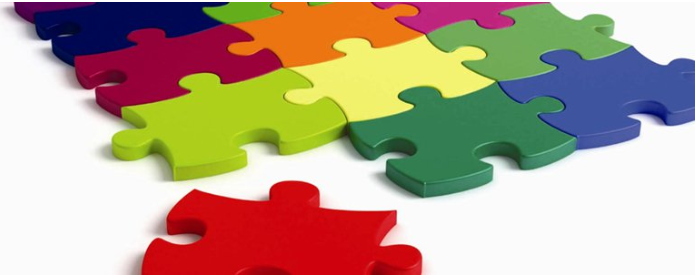
Posted by Andrea Mendoza, BSc, MPT, July 29, 2014
Physiotherapy is a never-ending puzzle. That’s the challenge of this profession – we are constantly being driven to expand our anatomical and functional knowledge, amp up our kinaesthetic abilities for assessment and treatment techniques, and cultivate our movement creativity.
In 2011, I completed the Master of Physical Therapy program at the University of British Columbia, and graduated with similar knowledge and experience to the other 66 students in my class. I was given the opportunity to work at Kids Physio Group, the first private paediatric clinic created to serve the greater Vancouver area. Entering the world of pediatrics right after graduation was daunting, as I was concerned that I didn’t possess enough pieces of the puzzle to enter this realm. I felt I hadn’t learned sufficient anatomical or functional knowledge regarding a kiddo’s growing body, nor was I prepared with any specialized treatment techniques for the plethora of pathologies that might present in the pediatric world. I also didn’t think I was very creative (as I believed I was always more “left-brained” and factual). Needless to say, I was hesitant to start a career in such a specialized field. Now, after three years of working at this unique facility, I realize that the physiotherapy aspect of this job is only a small piece of what makes paediatric physiotherapy such a puzzle.
The complexity of cases in paediatrics never ceases to amaze me. This past spring, I met an amazing 4-year-old girl who was born to a substance-abusing mother. She and her twin sister were adopted into a phenomenal and passionate family who goes to great lengths to give them all they need and more. This young girl was diagnosed with diplegic cerebral palsy, has an array of serious gastric issues and associated surgeries, and is completely hearing impaired (which has led me to late-night googling of physio- and play-related sign language and using my NetFlix account to access “Signing Time”). I’ve learned to quickly set up a puzzle, stabilize this squirmy child’s pelvis to help her step up onto a box, and simultaneously sign “Great job! Again!” ten times in a row while wiping my glistening brow in between reps. And despite all of the challenges she faces on a daily basis, this girl is a determined and strong-willed child whose cheerfulness is infectious, and I look forward to problem-solving all aspects of her treatment and learning from her every week.
It’s slowly becoming clear to me that family structures and social dynamics are complex and can strongly contribute to a child’s success in a rehabilitation setting. As a late-twenties young professional who has very few friends with children, I had to dig deep into the memory bank to empathize how it might feel to be in highschool at 15-years-old, living under my parents roof, and worrying that if I might not be a part of the popular crowd if I didn’t make the cut for the volleyball team because my physio told me to rest my knee. I’m understanding that kids are pressured from all directions – school, peers, sports, and home – and these puzzle pieces need to be taken into account as I create my overall treatment plan.
Many therapists may agree that perhaps the largest puzzle piece in paediatrics is solidifying a child’s buy-in and compliance to complete an activity that causes discomfort in the form of pain or difficulty. We see many children and youth of all ages that require a regular stretching program, but as many of us know, stretching is uncomfortable and boring. Similarly, some children present with lower muscular tone than average which limits them from participating to the same level as their peers. A regular strengthening program is the typical course of action however the trick is to devise a series of games or activities that encourage the child to complete the recommended sets and reps despite ‘feeling the burn’.
Additionally, I’ve learned that it’s crucial to establish authority within the first few sessions to maximize the therapeutic relationship between myself and the child. Building a solid sense of trust through exciting games, meaningful conversation, and fulfilled promises for rewards and end-of-session “Thomas The Train” stickers leads the child to happily participate throughout the intense 45-minute treatment session.
Pathologies and conditions certainly differ between the adult and child populations, but paediatric physiotherapy is so much more than the anatomical and physiological side. It is an art that combines mastering behavioural strategies, possessing continual ingenuity for games and obstacle courses, and having an ability to relate to any child regardless of their age, cognitive ability, or physical state. Nothing in school could have prepared me for this extensive puzzle, as I’ve found that much of this can only be learned through on-the-job successes and even greater failures. I still get a bit nervous when a new assessment walks through the door, but get excited as I start to unfold various pieces of that puzzle. After all, it is fascinating to witness the progress that evolves when those puzzle pieces come together and overall picture of a child becomes apparent.
Andrea Mendoza, BSc, MPT
Physiotherapist

If you are NOT a Healthcare Professional but have a question? Click here >
Free Shipping
On orders over $250
Learn More>
Get Expert Advice
For Healthcare Professionals only
1-800-561-0310
Contact us >
Technical Support
Does your equipment need
maintenance or calibration?
Contact us >
Finance Your Success
Leasing equipment is simple?
Learn more >
Customer Service Hours: Monday to Friday from 8:00 AM to 5:00 PM EST
Fax: 1-800-561-0349
Mailing Address: 170 Bombardier, Unit 1, Gatineau, QC J8R 0G5